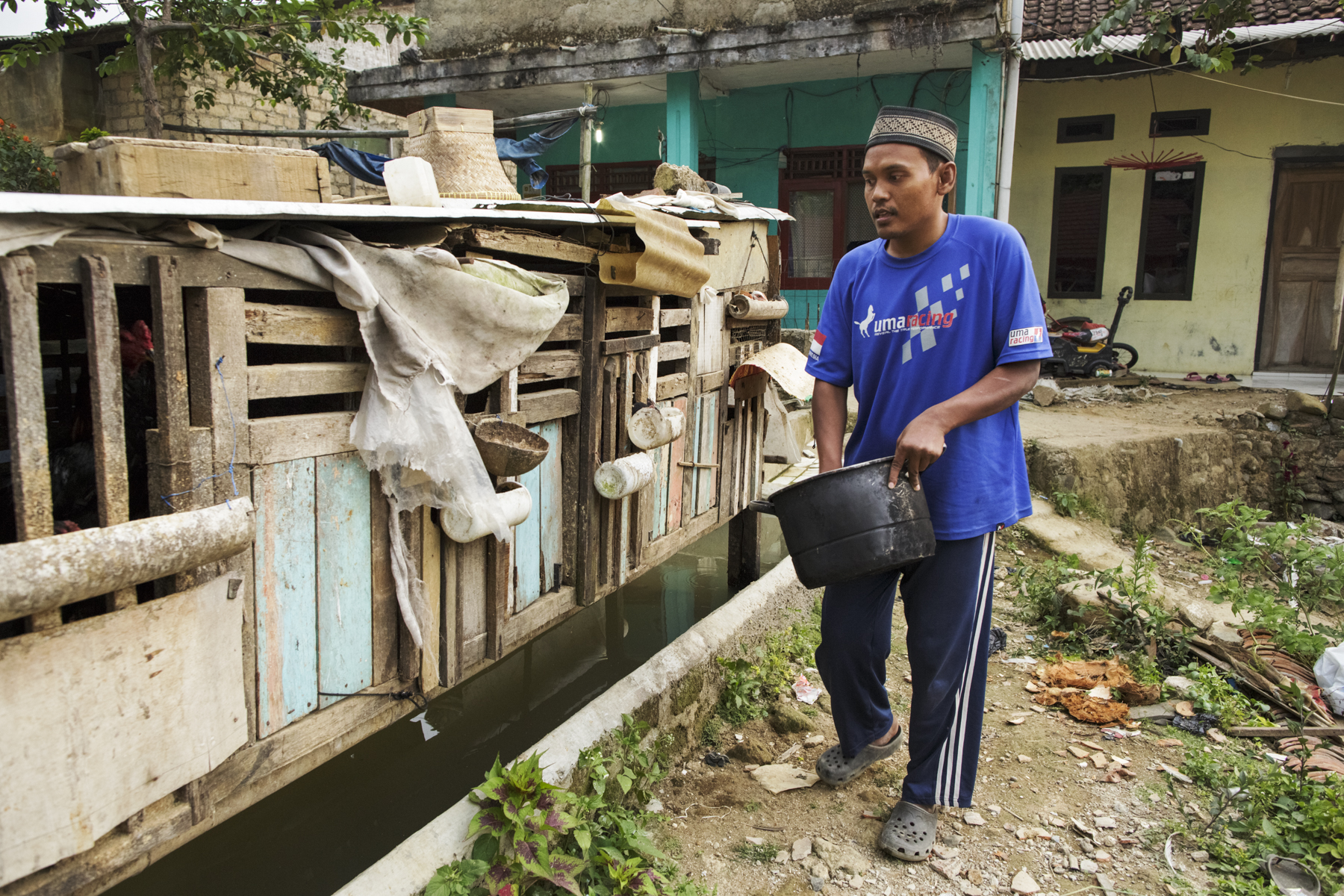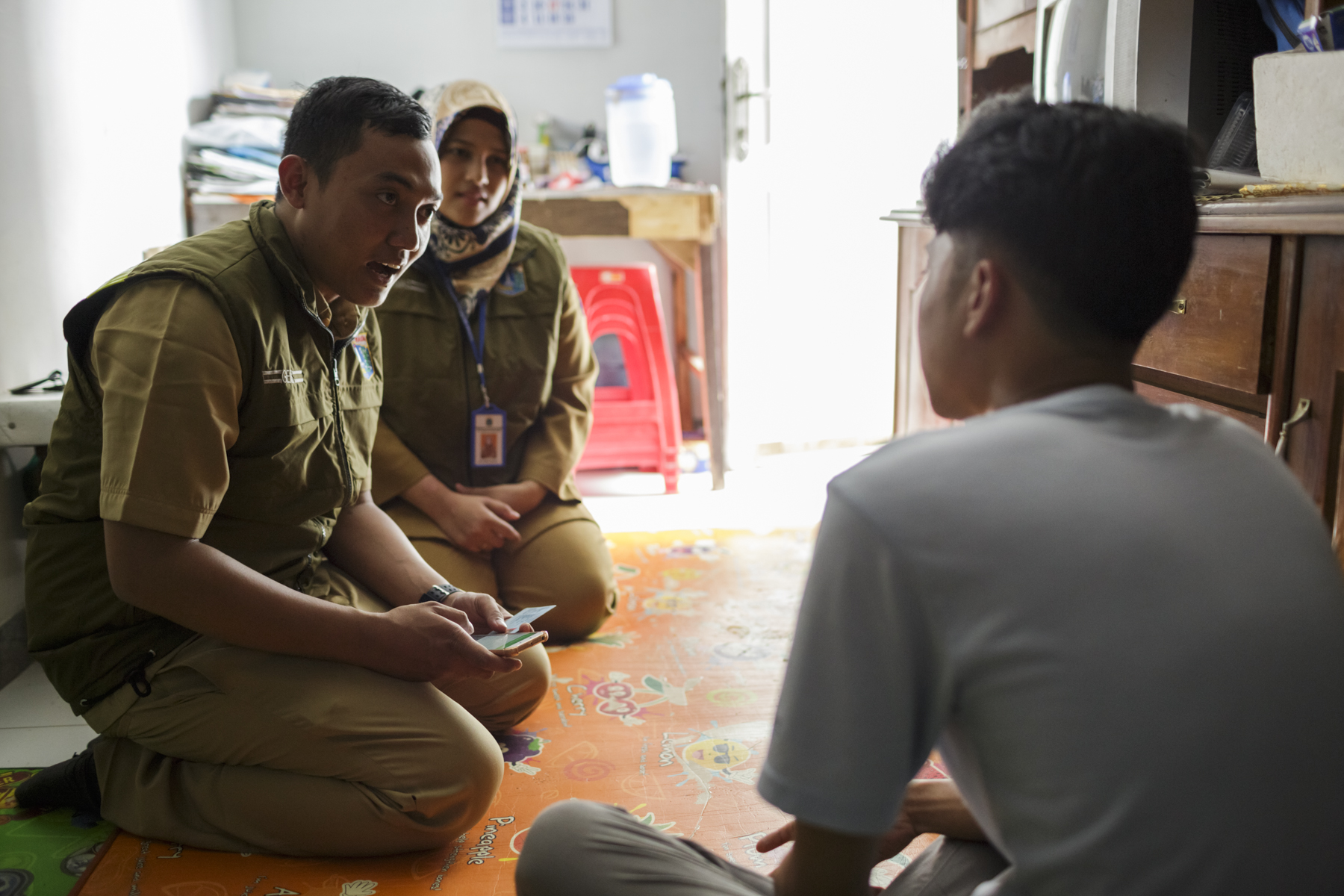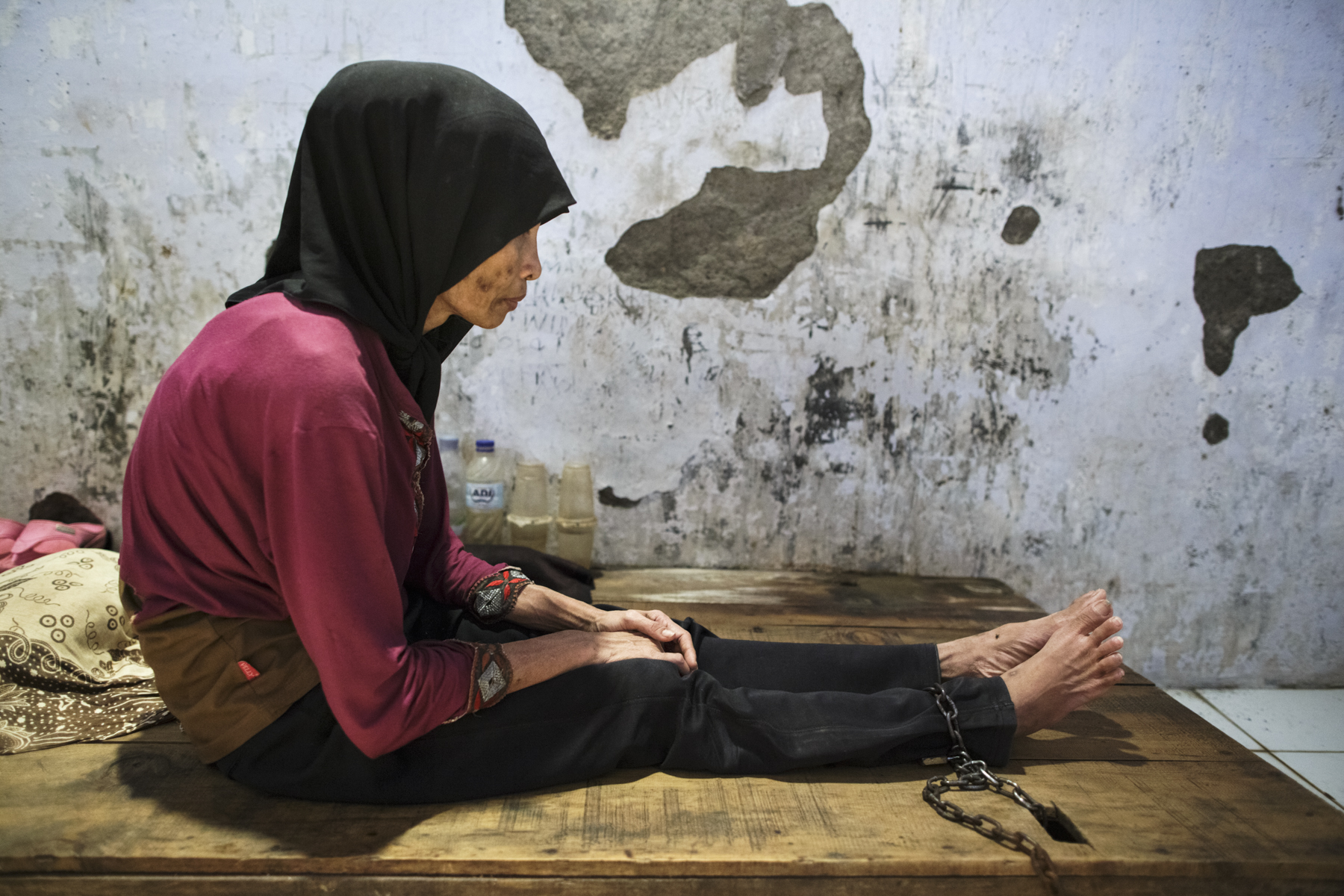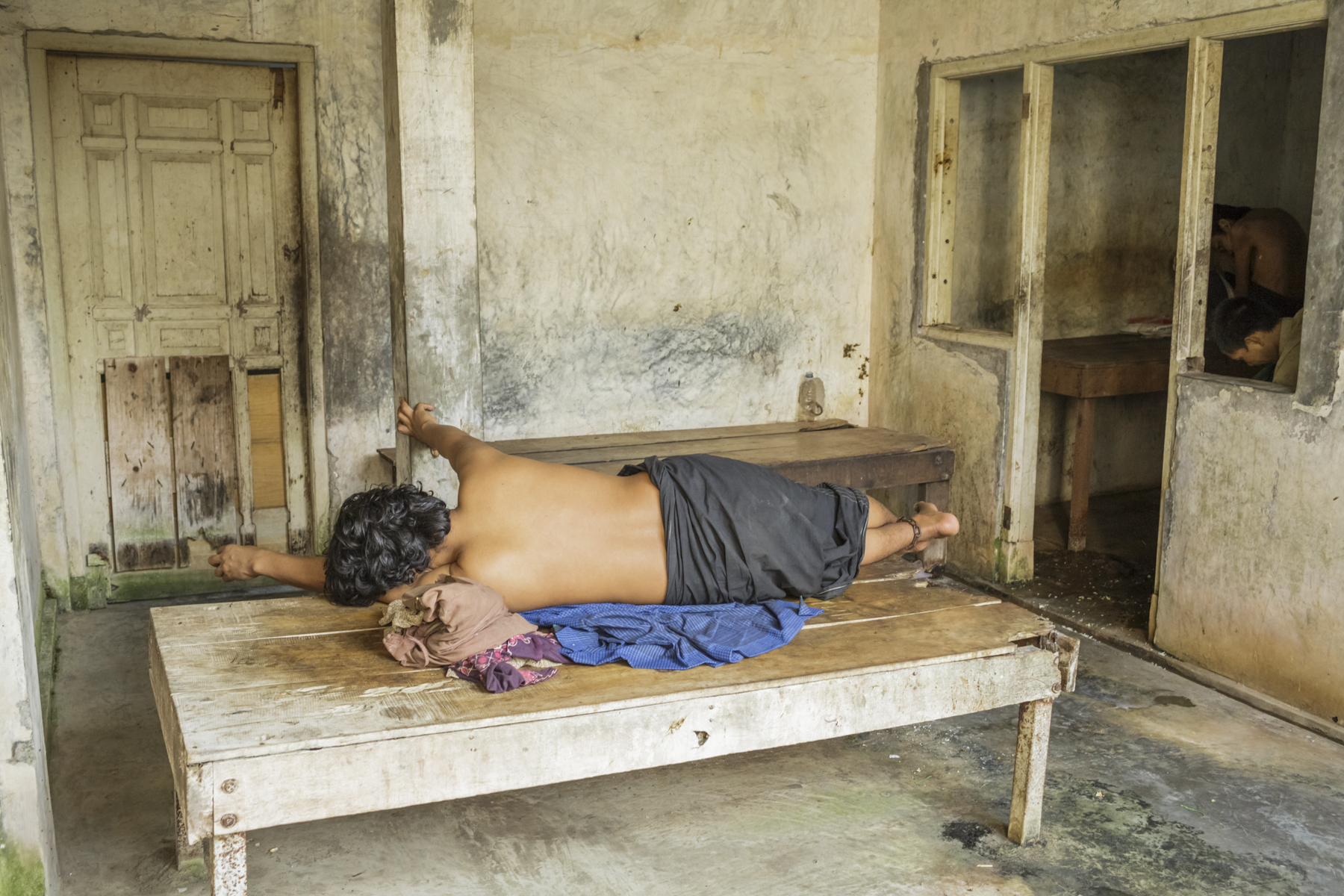Shackling people with mental health conditions has been commonplace in Indonesia for years. Pictures of emaciated men and women chained to their hard, wooden beds are hard to get out of your mind. But there is some hope. The number of people in shackles has dropped from 18,800 – the last-reported figure – to 12,800 in July 2018.
Sodikin and Asep are two of the people who have been freed.
Sodikin
There used to be a hut next to a family’s home in Cianjur, West Java. In it, a man named Sodikin lived locked up and unable to stand. He ate, slept, and went to the bathroom in the hut, which had one window no bigger than the palms of his hands. His light at night came from a solitary lightbulb his family hung in the hut.

Everything changed when Indonesia decided to support people with mental health conditions – and their families. Now Sodikin goes to work each day and earns money to support his family – the same people who left him shackled for eight years. He has made friends; he has learned skills.
His family burned the hut to the ground. A garden grows there now.
In Indonesia, misunderstanding about mental health is rife, and Sodikin’s family had no idea how to support him when he developed a mental health condition. He would get angry, smash things, and yell. First, they took him to a faith healer, and then they took him to a mental health hospital a day-and-a-half walk from their home.
“The thing with this family is that they did try,” said Kriti Sharma, senior disability rights researcher at Human Rights Watch.
The family was given medicine for Sodikin, and it helped for a while, but then when it came time for a refill of his prescription, no one provided it. The local healthcare center told his father to go back to the hospital. But after he walked the day-and-a-half to get there, the hospital turned him away, saying he had to get the refill locally.
“They didn’t know what to do, so they gave up,” Sharma said. That’s when they began shackling Sodikin.
Sharma first saw Sodikin while visiting Indonesia in 2014.
“Dusk was falling as we walked down this dirt path and I saw the parents and said, ‘We hear your son is here, can we speak to him?’”
The father pointed to the hut, which stood next to the family bathroom.
“I thought, ‘It’s not possible someone is living in there,’” said Sharma. “I peered in this tiny hole and he was just sitting there, all skin and bones, with his head hanging down.”
“Now the breadwinner in this family is [Sodikin]. The most valuable moment would be when I see him giving my kid some pocket money. I was quite surprised he could be that kind to my kid.”
When Sharma returned two years later to finish her report “Living in Hell: Abuses against People with Psychosocial Disabilities in Indonesia,” Sodikin was still there. Sandi, his brother-in-law, was the only family member who was looking after him.
“I left feeling so hopeless,” Sharma said. “I was sure he would die in that shed.”
But for Sodikin, transformation began when a nongovernmental organization rescued him. Sandi had to carry Sodikin out of his hut because his muscles had atrophied so much he couldn’t walk.
He was taken to a shelter run by the nongovernmental organization, where he was finally given the help he needed.
He stayed at the shelter for six months and slowly began to recognize people, including Sandi, who had joined the family several years after the shackling began and whom Sodikin had never really known.
“Now the breadwinner in this family is [Sodikin],” Sandi said. “The most valuable moment would be when I see him giving my kid some pocket money. I was quite surprised he could be that kind to my kid.”

Sodikin now works at a clothing factory stitching buttons onto boys’ school uniforms. The past eight years have been a blur for Sodikin, being shackled was so traumatizing that he has blocked out years he spent in the hut. But sometimes he has moments when he remembers being in chains.
“He does sometimes ask his parents ‘How could you do this to me?’ when he remembers,” Sharma said. “They have asked his forgiveness multiple times.”
Asep
Families in Indonesia often feel desperate when someone in their family starts displaying signs of a mental health condition. There is a lot of stigma in Indonesia surrounding mental health, and when Asep started declining his neighbors complained about his behavior.
“The family didn’t want to see him shackled, it was sad to see it,” Asep’s sister Ernawati told Sharma.
“The first time he was in shackles, everybody was crying, we had no option.”
Asep was found shackled at the waist in an abandoned house opposite his family’s home. The chain was so heavy it took rescuers 15 minutes to saw through it.

“He was found by a community worker who was going door-to-door as part of the new program,” said Sharma. “She was told there was a man shackled in the building, otherwise looking at it you would never know someone lived there.”
When he was freed from his shackles, Asep spent a month in a mental hospital, and after his release the local community health center made regular follow-up visits to his home. These visits enabled the family was able to keep him out of chains.
“They even did a briefing in the village to explain why shackling people with mental health conditions is never okay,” Sharma said.
Asep has changed a lot since he was first found by the outreach worker.
“The day he was released, he hung his head and did not make eye contact,” said Sharma. “His sister thought he was embarrassed to be found like that.”
The derelict house where he was shackled is no longer there. Now ponds have been created on the site. These days, Asep farms fish in the ponds. On an island in the middle of the ponds stands a chicken coop, and he also feeds the birds calmly and gently.
“He’s a man of few words,” Sharma said, “but when you ask him what it is like to be free he says, ‘In chains I felt rigid all the time, I am happy now I am free.’”
Shackling reduced, but persists
The Indonesian government has taken important steps to end the practice of shackling people with mental health conditions, Human Rights Watch said today. But many people remain locked up in institutions instead of being able to live in the community.
The number of people with psychosocial disabilities (mental health conditions) who are shackled or locked up in confined spaces dropped from nearly 18,800, the last reported figure, to about 12,800 in July 2018, according to Indonesian government data. The change resulted in part from community outreach to over 16.2 million households.
“The Indonesian government has made a serious effort to tackle the practice of shackling and the lack of community-based mental health services,” Sharma said. “But with little oversight, thousands of people with disabilities remain in chains or locked up in institutions across Indonesia.”

Human Rights Watch found in its 2016 report, “Living in Hell: Abuses against People with Psychosocial Disabilities in Indonesia,” that thousands of people with psychosocial disabilities were shackled and many were forcibly detained in overcrowded and unsanitary institutions. The practice persisted despite a 1977 government ban on shackling because of stigma and the lack of community-based support or mental health services.
Since then, Human Rights Watch has visited Indonesia five times to monitor government progress in addressing the problem. Human Rights Watch conducted 19 interviews with people with psychosocial disabilities and 48 interviews with family members, caregivers and institution staff, health professionals, disability rights advocates, and government officials across Jakarta, Bekasi, Bogor, Cianjur, Brebes, and Tegal.
Over the past two and a half years, the government has taken promising steps to address shackling. In April 2016, Health Minister Nila Moeloek made a commitment to make mental health medication available in community health centers across the country.
By January 2017, the Health Ministry rolled out Program Indonesia Sehat dengan Pendekatan Keluarga (Healthy Indonesia Program with Family Approach), a community outreach program in which health workers use a “family-based approach,” going house to house to collect data, raise awareness, and provide services relating to 12 measures of family health, including mental health.
As of September 2018, the program had reached 16.2 million – roughly 25 percent – of Indonesian households. The data collected indicates, however, that only 16 percent of people with psychosocial disabilities surveyed have access to mental health services.
A 52-year-old woman with a psychosocial disability was one of many rescued by community health workers in Cijeruk, Bogor. “We locked her in her room for five years,” her sister said. “She would sleep on the floor; she couldn’t walk because her muscles had stopped working. We gave her a bucket to urinate and defecate in. It was very smelly. It made me very sad.”
The family felt they had no alternative but to lock her up. But after a visit and help from outreach workers, her sister said, the family released her from her room in February 2017 and she is now receiving services in the community.
“Integrating mental health into primary health care is crucial but it’s not enough,” Sharma said. “To eliminate shackling, the government needs to educate the public about mental health and provide people with psychosocial disabilities with services that extend beyond medication, including access to education, housing, and employment.”

Human Rights Watch found that people with psychosocial disabilities continue to be arbitrarily detained in faith healing centers, social care institutions, and mental hospitals. In the absence of regular monitoring, little has changed in faith healing centers, where people are shackled, abused, and forced to take alternative “treatments” such as herbal concoctions, vigorous massages by traditional healers, and forced listening to Quranic recitations. In private institutions, people with psychosocial disabilities routinely face abuse including physical and sexual violence, involuntary treatment, restraints, and forced seclusion.
At Yayasan Galuh Rehabilitation Center in Bekasi, a woman in her mid-thirties with a psychosocial disability, said: “I used to be chained at home. My family tricked me into coming here. They told me my mother had passed away and they were taking me to her funeral. Instead they brought me here. I was locked in an isolation room for four weeks because I got into a fight.”
The Ombudsman, National Human Rights Commission, and National Commission on Violence against Women should immediately order inspections and regular monitoring of all government and private institutions and take appropriate action against abusive facilities, Human Rights Watch said. The Social Affairs Ministry also has a responsibility to regulate private institutions and ensure that it is not inadvertently enabling abusive practices.
“Despite the progress, the government has a long way to go to end abuse in institutions,” Sharma said. “The Social Affairs Ministry needs to adopt a deinstitutionalization policy that moves away from warehousing people in institutions and supports independent living in the community.”
Philippa H Stewart is a Senior Media Officer at Human Rights Watch.



Reader Interactions